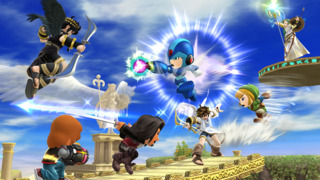Etymology
 Smashdown on Skyworld
Smashdown on SkyworldPlatform Fighters originated as a term from the Smash Bros community in the 00s to recognise a growing sub-genre beyond imitations of Super Smash Bros. The "Platform" part acknowledges the platformer-like freedom of movement and potential stage design. "Fighter" nods towards competitive fighting games between human players in general.
The term was also discussed and agreed upon during a 2017 Developer Roundtable titled "The Rise Of The Platform Fighter" between staff from Brawlhalla, Rivals of Aether, Brawlout and Icons: Combat Arena.
Other common terms which had use included "Smash Clones" due to the prominence of the Super Smash Bros. franchise and akin to "Doom Clone" (prior to First Person Shooter) or "GTA Clone" usually derogatorily, In addition to this, "Party Fighter" "Arena Fighter" (that was also being used to define another style of fighting game) and "Brawler" have been commonly used to discuss similar games.
Overview
Platform Fighting games or Platform Fighters are a sub-genre of 2D fighting games, which tends to emulate the Super Smash Bros. series by:
- Granting characters increased freedom of movement.
- Having larger stages with platforms which play a part in combat.
- Redefining the victory condition to differ from doing damage to claim victory.
Freedom of movement
Unlike traditional fighting games whether 2D or 3D, there is generally no focal adherence, a type of lock on which binds a character's movement and inputs towards a target. The change in how movement works also leads to these games having the block mechanic mapped to a button (directional blocking being accessed by angling the shield) as holding a directional input away from an opponent both turns you and moves you away at all times.
This comes with players being able to approach as fast as they can escape along with a reduced focus on commands to perform the most powerful attacks. There are exceptions, however, such as Ryu who has command based attacks in Super Smash Bros. for Wii U/Nintendo 3DS and also has focal adherence in Super Smash Bros. Ultimate when there is only one foe.
Aerial Dodging is a relatively common compliment as a risky defensive option in the air which sometimes comes with the ability to wavedash.
Larger stages
In conjunction with more free movement, these games tend to have varied stages in scale which is usually accompanied by a panning camera which can show characters and other points of interest. This differs from typical fighting games as the camera's view box may limit movement less or have lesser implications on repeatable actions (see how Hadouken can be performed again when the projectile is off-screen in SF games).
In many cases, the stages also come with stage hazards ranging from moving platforms to bosses which can play a part in combat adding onto the frequent appearance of items. However, the random elements along with unbalanced design behind some of these have negative effects on the competitive play of these games leading to players to limiting the stage options.
To counteract this, recent games have looked into allowing players to toggle stage hazards in addition to items.
Claiming victory
Following the Nintendo 64's Super Smash Bros., it is very common for games in the genre to have knockback and hit stun increase as the character takes damage which is represented with a rising %/Percentage taking the place of health bars. This comes with the goal of ringing out foes in any direction of a bottomless pit (including upwards) to claim lives/retries/points.
There are however some games which combine the ring-out system with a traditional health one like Jump Super Stars, have health but limited damage from ring outs like One Piece: Gigant Battle and even titles that have neither traditional health or a ring-out system like PlayStation All-Stars Battle Royale. In the latter, the player earns "AP" (Action Points) as a part of a Super Meter to perform super moves which are the only way to earn points. It is worth noting that the last three games named didn't feature increasing knockback, but ring outs still vary in their effects.
In addition to this, the Smash series has included an option based on hit points called "Stamina Mode" since Super Smash Bros. Melee, where the increasing hit stun & knockback being are a reduced factor, especially when certain stages such as custom ones are used to make ring outs nigh-impossible. There are also cases where players can only win by collecting items of some description or playing in a stylish way, both modes reduce the focus on ring-outs AND doing simply doing damage though doing so can benefit the player.
Log in to comment